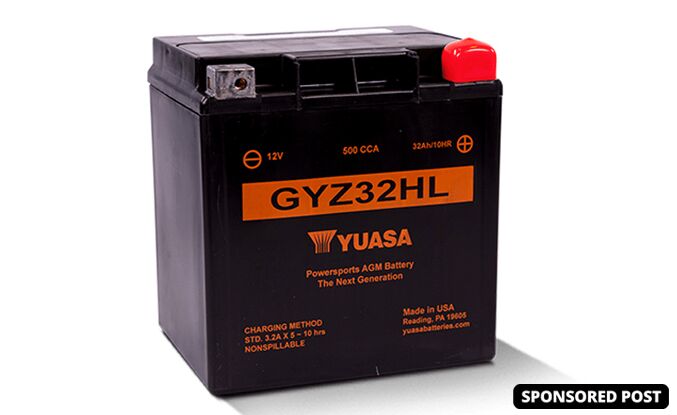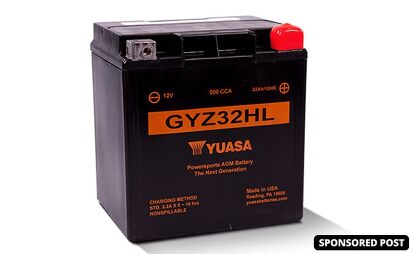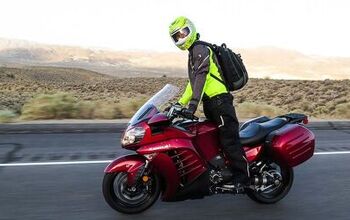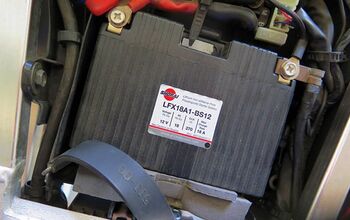Lead-Acid Batteries Still Have It
With a portion of riders switching to lithium ion batteries, where do things stand when it comes to lead-acid batteries?
Your motorcycle’s battery is one important piece of equipment. Without a healthy battery, you’ll be stranded.
Today one battery still reigns: the lead-acid battery. We’ll highlight how lead-acid batteries perform from the coldest to high heat environments. The durability, survivablty and sustainability of the modern lead-acid battery is superior. Even the weight-obsessed super/hyper cars on the road today still use lead acid batteries—and so should you.
If It Ain’t Broke…
Standard lead-acid batteries have been around since the mid-1800’s and they’ve stayed relatively unchanged in that time. Lead-acid batteries have a basic construction: a plastic casing with six cells. In each cell, there are plates that are immersed in a solution made of sulfuric acid and water to form what’s called an electrolyte.
There are two main types of lead-acid batteries – Wet cell (also known as flooded or vented) and sealed. Wet cell batteries have a liquid electrolyte solution inside the battery that mixes with the active material to create a chemical reaction. During the chemical reaction (charging), some hydrogen and oxygen escapes, hence why every motorcyclist knows to keep distilled water on hand for that reason. Sealed batteries are a little different in that the electrolyte solution is permanently suspended within the batteries. For example AGM (absorbent glass mat) batteries include fiberglass separators that act like a sponge to keep the plates in constant contact with the solution.
Advantages of Lead-Acid Batteries
Lead-acid batteries are great because they’re relatively inexpensive to manufacture, can be recycled easily, and they benefit from a long history of reliable service and well-understood technology.
Another advantage of lead-acid batteries is its ability to start in both cold and hot temperatures. Lithium ion batteries don’t start as quickly when in cold temperatures, especially if they’ve been cold-soaked for a few days. They’ll need to be woken up before cranking. Also in some high heat enviornements, lithium ion batteries will just simply shut down, similar to cell phone batteries.
How to Keep Your Battery Happy and Healthy
Motorcycle batteries, especially when well-manufactured and engineered, should last at least two years. That period of battery life can likely double when cared for correctly.
Initialization
Initializing your battery is key to keeping your battery healthy for a longer period of time. The initialization and activation process includes surveying and testing the status of your battery to make sure its functioning properly. Key to this process is using the correct charger. You’ll need a charger that is capable of initializing to a minimum of 12.8 volts.
Storage
We cannot stress enough how important storage is to the life and performance of your motorcycle battery. It really makes all of the difference.
Every battery has a shelf life set by the manufacturer that guarantees battery operation up to that date. That’s not the say you can’t get more out of your battery past that date. One of the best things you can do for your battery is to learn how to properly store it.
Temperature plays an important role in storage, charging, and starting. Batteries don’t turn off, they’re always in a state of either discharge or charge. When not in use, batteries will self-discharge and that discharge rate is faster when in hotter temperatures.
Store your battery ideally at a temperature between 60° F and 80°F when not in use. Be sure it’s not stored at near or below freezing temperatures– keep in mind the water in your battery could freeze which could cause the casing to crack.
Another way to get the most out of your battery’s life is to use a battery maintainer when not in use for long periods of time. Battery maintainers have many benefits including algorithmic charging, auto charging, active desulfation, and battery health detention meters. It’s a must-have for any cycle-head.
As with any piece of equipment you own, the better the brand, the better the results.
Refer to this helpful winter storage guide from Yuasa Battery.
The Trend Towards Lithium Ion Batteries
Why mess with 150+ years of a good thing?
A recent newcomer in the battery scene, lithium ion batteries have emerged as a contender to the tried and true lead-acid battery standard. Generally speaking, they’re lighter, they don’t contain lead, and they don’t discharge as quickly as lead-acid batteries.
That’s not to say that lithium ion batteries don’t come with their own set of challenges.
While lithium ion batteries have a higher energy density than lead-acid batteries, they’re not for every motorcycle. Particularly in bikes built prior to 1980, the charging systems cannot handle the new lithium ion technology. Your charging system needs to be in top-notch condition.
Lithium ion batteries are also more expensive. They can be anywhere from 50 to 200 times more expensive than a sealed lead-acid battery.
The Bottom Line
Regardless of their flaws, there’s no denying that lithium ion batteries have not only changed the motorcycle battery scene but have changed electronics as a whole. With each passing year, new improvements continue to be made with lithium ion technology and there are no signs of stopping.
You might be wondering how a 150+ year old battery can compete in this modern climate. The answer is that it sure can! With proper storage, care, and recycling methods, lead-acid batteries will continue to be a leading choice for motorcyclists for many more years to come.
While lithium ion batteries may be light and nimble, you know you’ve got a good thing going when your bike rolls off the assembly line fitted with a lead-acid battery. You can’t argue with reliability.
Simply put, we know the tech and we know it works.
For more information about lead-acid batteries, check out Yuasa Battery to find the perfect battery for your ride. https://www.yuasabatteries.com/
More by Sponsored





































Comments
Join the conversation
Good piece!
50 to 200 percent, not times, is what you meant to say?